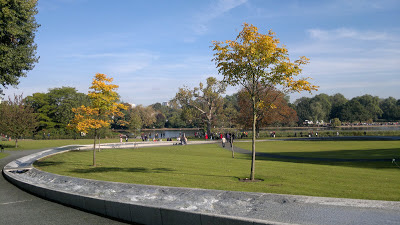Last Sunday was the annual firm's outing - this year the venue was the Science Museum. Thanks to the time-tabling of Southern Railway, I reached London early but as the weather was so good I took the tube to Queensway and walked through Kensington Palace Gardens via the Diana, Princess of Wales’ Memorial Fountain to the museum on Exhibition Road..
William III bought what was originally part of Hyde Park in 1689 and created Kensington Gardens. They now cover 260 acres and are the setting for Kensington Palace, the birthplace of Queen Victoria. There are various statues and memorials including a granite obelisk erected in 1866 to remember John Hanning Speke, the explorer who discovered the Nile and Lake Victoria.
Another statue comprises a huge bronze of a man on horseback. called the 'Physical Energy' statue it was designed by George Frederick Watts in 1907. To the right is a drinks station for the Royal Parks Foundation Half Marathon which was taking place while I was there.
John Rennie's Serpentine Bridge which was built in the 1820's to carry the new West Carriage Drive along the boundary between Hyde Park and Kensington Gardens, dividing the lake into the Serpentine (east) and the Long Water (west).
Views from the bridge - first to the west and the Long Water.....
.....and to the east and The Serpentine. This covers 40acres and was created for Queen Caroline ( wife of George II) in 1730. The name comes from the colour of the water.
On the south side of the Serpentine (where I took the photo of the bridge), stands a three-metre tall bronze ibis - the first sculpture to be unveiled in Hyde Park for 50 years. The artwork by Simon Gudgeon is called Isis (the goddess of mother
nature) and is helping to spearhead a fundraising drive to
raise £1.8m to build an eco-friendly wildlife education centre in the
park.
In the distance (on the far side of the lake) are the marathon runners.
Today was the first time I have been to the Diana, Princess of Wales’ Memorial Fountain. This comprises an oval stone ring of moving water, measuring 210m in circumference made from 545 pieces of
Cornish granite.
Water flows from the highest point of the fountain in two directions,
bubbling along a gentle slope on one side and cascading down the
other before meeting in a calm reflecting pool. It is said that the water’s journey echoes Diana’s life, from joy and energy through
turbulence to tranquillity.
It was unveiled by HM The Queen on 6 July 2004.
Exhibition Road, which runs from Hyde Park in the north to South
Kensington in the south, is home to the
Victoria and Albert Museum, the Natural History Museum, the Science
Museum, the Royal Albert Hall and Imperial College London.
The new facade to the Mechanical Engineering Annex of Imperial College on Exhibition Road.
A couple of photos just to show I did actually go into the Science Museum.
The impressive facade of the Henery Cole Wing of the Victoria and Albert
Museum - The building was originally constructed as the School of Naval
Architecture in 1871 but has also been known as the Royal College of
Science, and Huxley Building before its current reincarnation.In 1978
the building was converted to house the Department of Prints, Drawings
& Photographs of the V&A and renamed the Henry Cole
Building. Henry Cole was the first director of the South Kensington
Museum (now the V&A).
The Waterhouse Building of the Natural History Museum is very impressive and a stunning work of art. It was designed by Alfred Waterhouse, a
young architect from Liverpool. He won the contract after the original
architect died (civil engineer Captain Francis Fowke). Waterhouse altered Fowke’s design from Renaissance to German Romanesque. Work began in 1873 and was completed in 1880. The new museum opened in 1881.
Subscribe to:
Post Comments (Atom)
















No comments:
Post a Comment